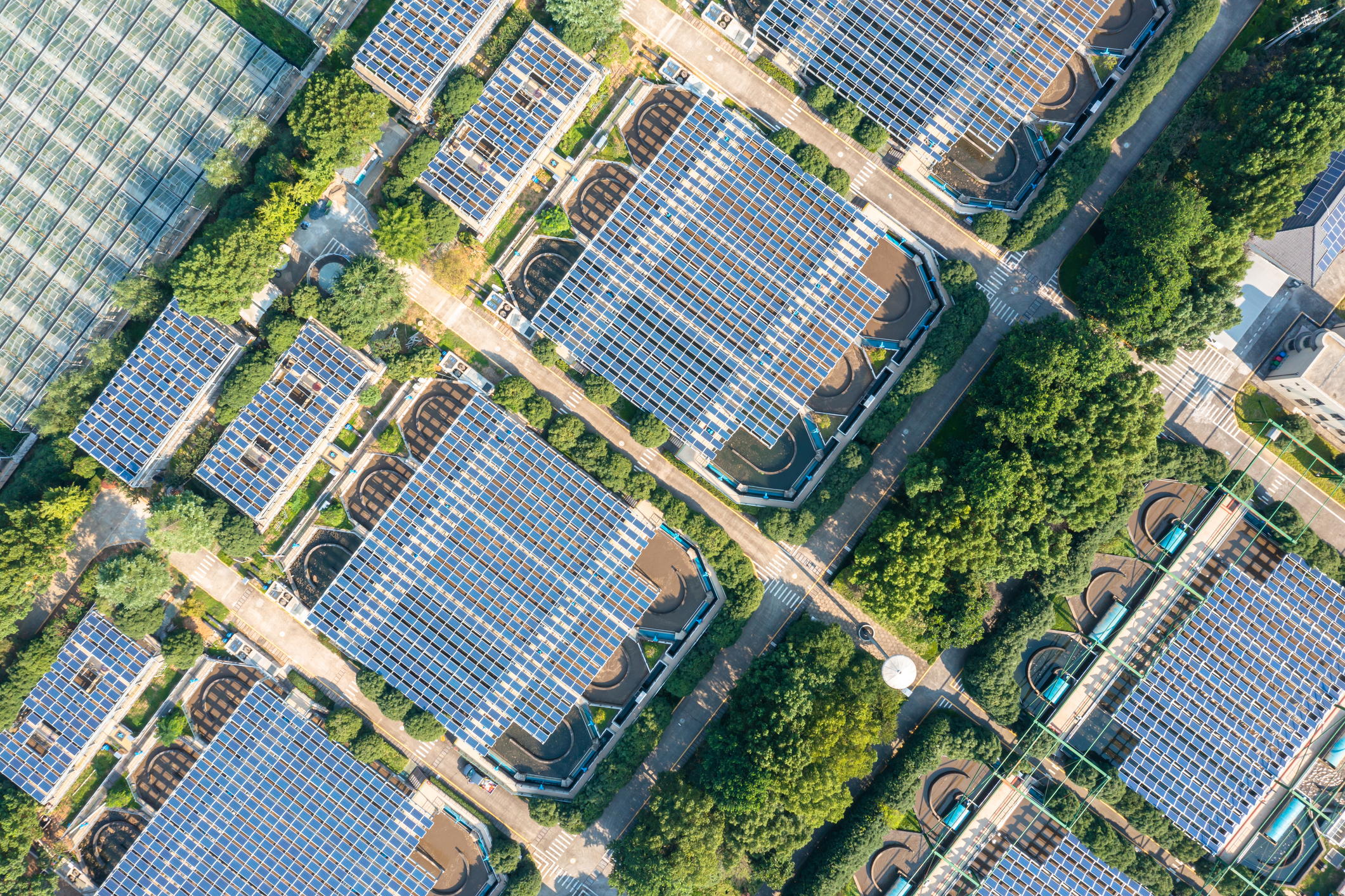China’s Carbon Emissions Are Set to Decline Years Earlier Than Expected
China’s massive rollout of renewable energy is accelerating, its investments in the sector growing so large that international climate watchdogs now expect the country’s greenhouse-gas emissions to peak years earlier than anticipated—possibly as soon as this year.
China installed 217 gigawatts worth of solar power last year alone, a 55% increase, according to new government data. That is more than 500 million solar panels and well above the total installed solar capacity of the U.S. They appeared everywhere from the deserts of Inner Mongolia to the mountains of southwest China to rooftops across the country, including on the Great Hall of the People on the edge of Tiananmen Square.
Wind-energy installation additions were 76 gigawatts last year, more than the rest of the world combined. That amounted to more than 20,000 new turbines across the country, including the world’s largest, planted on towers in the sea off China’s east coast.
The low-carbon capacity additions, which also included hydropower and nuclear, were for the first time large enough that their power output could cover the entire annual increase in Chinese electricity demand, analysts say. The dynamic suggests that coal-fired generation—which accounts for 70% of overall emissions for the world’s biggest polluter—is set to decline in the years to come, according to the Paris-based International Energy Agency and Lauri Myllyvirta , the Helsinki-based lead analyst at the Centre for Research on Energy and Clean Air.
China’s expanding renewables footprint is shaping the global response to climate change. Its companies are the leading manufacturers of clean-energy technology, from solar panels and wind turbines to electric vehicles. That is stoking concerns in the rest of the industrialized world about depending on China for their energy supplies in the future.
At the same time, China’s deployment of renewables at home is breathing new life into international climate diplomacy . Its rapid emissions growth long provided fodder for critics who said Beijing wasn’t committed to fighting climate change or supporting the Paris accord , the landmark climate agreement that calls for governments to attempt to limit warming to 1.5 degrees Celsius over preindustrial temperatures. Now, analysts and officials say Beijing’s efforts are lending momentum to the Paris process, which requires governments to draft new emissions plans every five years.
“An early peak would have a lot of symbolic value and send a signal to the world that we’ve turned a corner,” said Jan Ivar Korsbakken, a senior researcher at the Oslo-based Center for International Climate and Environmental Research.
In 2020, Chinese leader Xi Jinping pledged that the country’s emissions would begin falling before 2030 and hit net zero before 2060, part of its plan prepared under the Paris accord. He also said China would have 1,200 gigawatts of total solar- and wind-power capacity by the end of this decade. The country is six years ahead of schedule: China reached 1,050 gigawatts of wind and solar capacity at the end of 2023, and the China Electricity Council forecast last month that capacity would top 1,300 gigawatts by the end of this year.
“China’s acceleration was extraordinary,” said Fatih Birol , the executive director of the Paris-based International Energy Agency.
Chinese authorities publish regular data on energy consumption and generation but not overall greenhouse-gas emissions. Transition Zero, a U.K.-based nonprofit that uses satellite images to monitor industrial activity and emissions in China, says the official data are “broadly aligned and consistent” with theirs.
Once the peak arrives, some analysts expect an emissions plateau to follow rather than a rapid fall in the following years. That is a problem, scientists say, because the world’s major emitters must sharply cut global emissions this decade—by 43% compared with 2019—to fulfill the Paris accord.
Climate Action Tracker, a scientific consortium that evaluates governments’ emissions plans, rates China’s current policies as “highly insufficient” to meet the 1.5 degrees Celsius goal . Its latest analysis, published in November, says China’s emissions should peak by 2025. If wind and solar installations can average 300 gigawatts a year—as they did last year—China’s emissions should fall significantly by the end of the decade, the consortium says. The actions and policies of the U.S., where emissions have been falling, were graded as “insufficient.”
Still, moving China’s timeline for an overall emissions peak forward could shave off around 0.3 to 0.4 degrees Celsius of projected global warming if emissions started to decline next decade, analysts say. Emissions plans submitted to date under the Paris accord would put the world on track to warm by 2.5 degrees Celsius this century, a United Nations Environment Program report said in November.
China is still building coal-fired power plants , fueling criticism from Western officials that it is locking in carbon-dioxide emissions years into the future. Beijing has been telling Western officials that the new plants won’t be as polluting as they fear. They are replacing older, higher-emitting plants, and will run far below full capacity, used largely to maintain electric-grid stability as China generates more of its power from intermittent wind and solar. In November, China unveiled a system of capacity payments for coal-fired plants that will allow them to earn money even when they are running as backup power sources. Xi said in 2021 that China would begin to phase down its coal consumption starting in 2026.
The exact timing of China’s peak depends on factors such as economic growth and weather in the next few years, analysts say. Growth is expected to slow following China’s real-estate sector slump —unless Beijing undertakes a major new program of economic stimulus that would boost industrial emissions. Another spell of drought this summer would push the country’s coal plants to run harder to replace lost hydropower generation.
The most certain variable in the equation is the breakneck pace of China’s renewable-energy rollout, which analysts expect will continue to add 200 to 300 gigawatts of new wind and solar capacity a year. The investments in renewable energy have become a major driver of the Chinese economy. The country’s clean-energy spending totaled $890 billion last year, up 40%. Without that growth, investment in China would have been flat as the country reels from the slump in its real-estate sector, according to the Centre for Research on Energy and Clean Air.
The investments include clean-energy installations and the construction of enormous factories to produce solar panels, wind turbines, batteries and electric vehicles—turning the country into the leading manufacturer of clean tech. Its factories in those sectors now have plenty of unused capacity . The adoption of electric vehicles is happening so rapidly that analysts say peak gasoline demand in China was already reached last year.
At the United Nations COP28 climate conference in Dubai in November, Xie Zhenhua , then China’s climate envoy , said the government would calculate the year and absolute volume of the country’s emissions peak. He also said Beijing is drawing up its next emissions plan under the Paris accord.
“Our country will do as it’s said and strive to do even better,” he said. “I have faith.”
 Copyright 2020, Dow Jones & Company, Inc. All Rights Reserved Worldwide. LEARN MORE
Copyright 2020, Dow Jones & Company, Inc. All Rights Reserved Worldwide. LEARN MORE
Pure Amazon has begun journeys deep into Peru’s Pacaya-Samiria National Reserve, combining contemporary design, Indigenous craftsmanship and intimate wildlife encounters in one of the richest ecosystems on Earth.
Australia’s housing market defies forecasts as prices surge past pandemic-era benchmarks.
Selloff in bitcoin and other digital tokens hits crypto-treasury companies.
The hottest crypto trade has turned cold. Some investors are saying “told you so,” while others are doubling down.
It was the move to make for much of the year: Sell shares or borrow money, then plough the cash into bitcoin, ether and other cryptocurrencies. Investors bid up shares of these “crypto-treasury” companies, seeing them as a way to turbocharge wagers on the volatile crypto market.
Michael Saylor pioneered the move in 2020 when he transformed a tiny software company, then called MicroStrategy , into a bitcoin whale now known as Strategy. But with bitcoin and ether prices now tumbling, so are shares in Strategy and its copycats. Strategy was worth around $128 billion at its peak in July; it is now worth about $70 billion.
The selloff is hitting big-name investors, including Peter Thiel, the famed venture capitalist who has backed multiple crypto-treasury companies, as well as individuals who followed evangelists into these stocks.
Saylor, for his part, has remained characteristically bullish, taking to social media to declare that bitcoin is on sale. Sceptics have been anticipating the pullback, given that crypto treasuries often trade at a premium to the underlying value of the tokens they hold.
“The whole concept makes no sense to me. You are just paying $2 for a one-dollar bill,” said Brent Donnelly, president of Spectra Markets. “Eventually those premiums will compress.”
When they first appeared, crypto-treasury companies also gave institutional investors who previously couldn’t easily access crypto a way to invest. Crypto exchange-traded funds that became available over the past two years now offer the same solution.
BitMine Immersion Technologies , a big ether-treasury company backed by Thiel and run by veteran Wall Street strategist Tom Lee , is down more than 30% over the past month.
ETHZilla , which transformed itself from a biotech company to an ether treasury and counts Thiel as an investor, is down 23% in a month.
Crypto prices rallied for much of the year, driven by the crypto-friendly Trump administration. The frenzy around crypto treasuries further boosted token prices. But the bullish run abruptly ended on Oct. 10, when President Trump’s surprise tariff announcement against China triggered a selloff.
A record-long government shutdown and uncertainty surrounding Federal Reserve monetary policy also have weighed on prices.
Bitcoin prices have fallen 15% in the past month. Strategy is off 26% over that same period, while Matthew Tuttle’s related ETF—MSTU—which aims for a return that is twice that of Strategy, has fallen 50%.
“Digital asset treasury companies are basically leveraged crypto assets, so when crypto falls, they will fall more,” Tuttle said. “Bitcoin has shown that it’s not going anywhere and that you get rewarded for buying the dips.”
At least one big-name investor is adjusting his portfolio after the tumble of these shares. Jim Chanos , who closed his hedge funds in 2023 but still trades his own money and advises clients, had been shorting Strategy and buying bitcoin, arguing that it made little sense for investors to pay up for Saylor’s company when they can buy bitcoin on their own. On Friday, he told clients it was time to unwind that trade.
Crypto-treasury stocks remain overpriced, he said in an interview on Sunday, partly because their shares retain a higher value than the crypto these companies hold, but the levels are no longer exorbitant. “The thesis has largely played out,” he wrote to clients.
Many of the companies that raised cash to buy cryptocurrencies are unlikely to face short-term crises as long as their crypto holdings retain value. Some have raised so much money that they are still sitting on a lot of cash they can use to buy crypto at lower prices or even acquire rivals.
But companies facing losses will find it challenging to sell new shares to buy more cryptocurrencies, analysts say, potentially putting pressure on crypto prices while raising questions about the business models of these companies.
“A lot of them are stuck,” said Matt Cole, the chief executive officer of Strive, a bitcoin-treasury company. Strive raised money earlier this year to buy bitcoin at an average price more than 10% above its current level.
Strive’s shares have tumbled 28% in the past month. He said Strive is well-positioned to “ride out the volatility” because it recently raised money with preferred shares instead of debt.
Cole Grinde, a 29-year-old investor in Seattle, purchased about $100,000 worth of BitMine at about $45 a share when it started stockpiling ether earlier this year. He has lost about $10,000 on the investment so far.
Nonetheless, Grinde, a beverage-industry salesman, says he’s increasing his stake. He sells BitMine options to help offset losses. He attributes his conviction in the company to the growing popularity of the Ethereum blockchain—the network that issues the ether token—and Lee’s influence.
“I think his network and his pizzazz have helped the stock skyrocket since he took over,” he said of Lee, who spent 15 years at JPMorgan Chase, is a managing partner at Fundstrat Global Advisors and a frequent business-television commentator.
Once a sleepy surf town, Noosa has become Australia’s prestige property hotspot, where multi-million dollar knockdowns, architectural showpieces and record-setting sales are the new normal.
An opulent Ryde home, packed with cinema, pool, sauna and more, is hitting the auction block with a $1 reserve.























